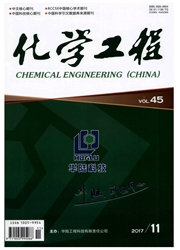

 中文摘要:
中文摘要:
国内Shell粉煤气化炉在长周期运行中曾多次出现大块熔渣堵塞渣池出口的现象,严重制约着工业化装置的安全、经济、稳定运行。为了探讨大块熔渣形成的原因,以Shell粉煤气化炉为研究对象,建立了其渣口区熔渣流动与传热模型。该模型可以预测固态渣层厚度、液态渣层厚度和渣层表面温度等。结果表明:气化炉运行时,由于熔渣的沉积,在渣裙表面将形成一定厚度的固态渣层。开车初期,熔渣全部被冷凝成固态渣,当渣层表面温度超过渣的临界温度,液态渣层开始出现,此后随着时间的增加,固态和液态渣层都继续增厚直至达到稳定状态。离气化炉渣口处越远,渣层厚度和表面温度就越大。气化炉渣口温度和沉积率越低,固态渣层厚度就越大,所需要的特征时间也越长。
 英文摘要:
英文摘要:
In China, there are often big slag blockages at the slag tap hole region of Shell gasifier during long time operation, which is an important threat to the safe, economic and stable operation of industrialization device. A model of flow and heat transfer of molten coal slag at the slag tape hole region of Shell gasifier was proposed to discuss the reason of slag blockage. The thicknesses of solid slag layer and liquid slag layer, and the surface temperature of liquid slag layer were predicted with the proposed model. The results show that there is solid slag layer with certain thickness on the slag screen wall because of slag deposition during gasifier operation. The slag is totally solidified to solid slag at early start-up. When the surface temperature is above the critical temperature, the liquid slag layer appears. The thicknesses of solid slag layer and liquid slag layer both increase with the increase of time until to its stable state. The farther the distance from the slag tap hole is, the thicker the solid and liquid slag layer are and the higher the surface temperature of liquid slag layer is. The lower the slag tap hole temperature and the deposition rate are, the thicker the solid slag layer is and the longer the characteristic time is.
 同期刊论文项目
同期刊论文项目
 同项目期刊论文
同项目期刊论文
 期刊信息
期刊信息
